This article is more than 5 years old.

When poet Seamus Heaney died last month at age 74, obituaries hailed him as the greatest Irish poet since William Butler Yeats. The New York Times noted that Heaney, who won the Nobel Prize for Literature in 1995,
was renowned for work that powerfully evoked the beauty and blood that together have come to define the modern Irish condition. The author of more than a dozen collections of poetry, as well as critical essays and works for the stage, he repeatedly explored the strife and uncertainties that have afflicted his homeland, while managing simultaneously to steer clear of polemic.
Heaney was born in Northern Ireland in 1939. The eldest child of a Catholic farming family, he showed his intellectual gifts early and was sent to boarding school and then to Queen’s University in Belfast, where he took an English degree and began writing poetry.
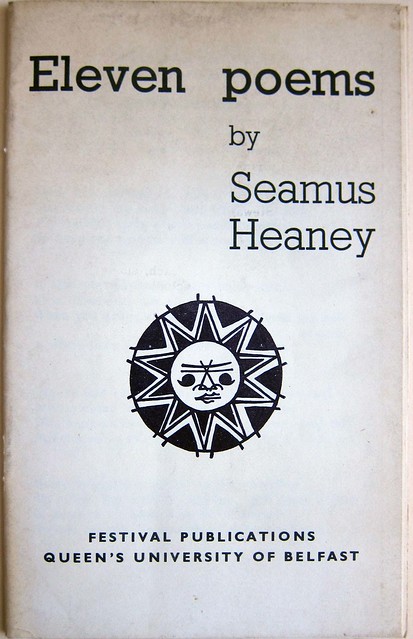
By 1965 Heaney had published poems in a number of magazines and newspapers. He submitted a manuscript for a book of poetry to Liam Miller, proprietor of the Dolmen Press in Dublin. Miller and his wife Josephine had founded the Dolmen Press in 1951 with the express purpose of publishing and encouraging Irish poets and artists, so it was a natural outlet for the young poet’s first publication. However, while Miller still had his manuscript under consideration, Heaney received an inquiry from an editor the London publishing firm Faber & Faber.
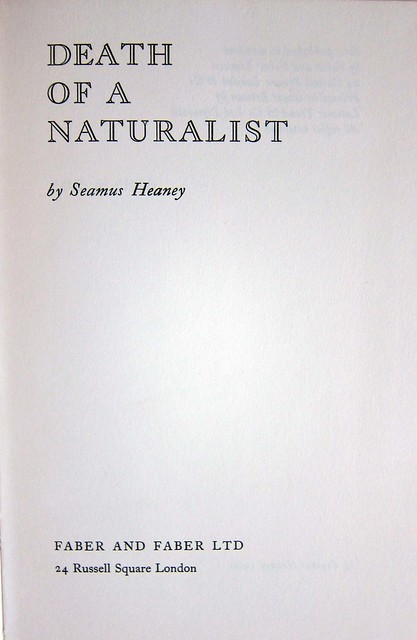
Heaney asked Miller to return his manuscript. As Clare Hutton observes in her introduction to The Oxford History of the Irish Book, Volume V, Heaney was influenced by the “cultural prestige” of the firm associated with T.S. Eliot, combined with the fact that “Faber was in a much more stable position than Dolmen, which, like many small Irish publishing houses, ran on a precarious financial basis.” So Heaney’s first volume of poetry, Death of a Naturalist, was published by Faber & Faber in 1966.
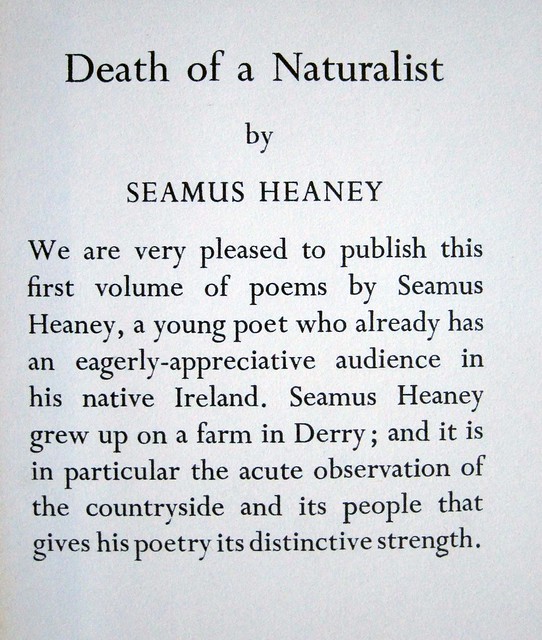
But the inscription in Liam Miller’s copy of Death of a Naturalist (now in ZSR Library’s Special Collections) suggests that he and Heaney remained on friendly terms.
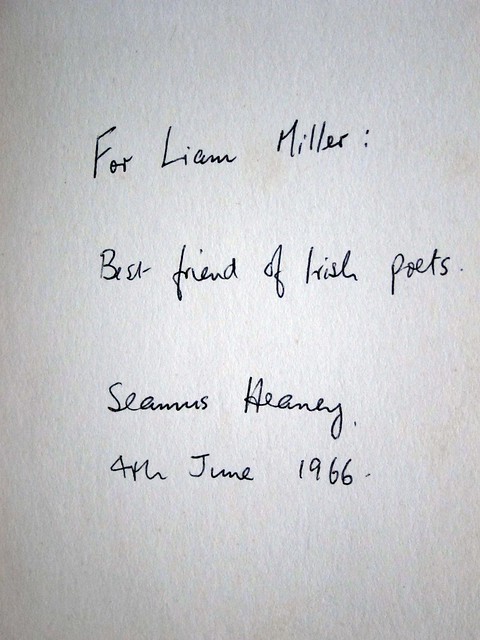
Death of a Naturalist was generally well received by the critics. Christopher Ricks wrote in the New Statesman (27 May 1966) that
Literary gentlemen who remain unstirred by Seamus Heaney’s poems will simply be announcing that they are unable to give up the habit of disillusionment with recent poetry. The power and precision of his best poems are a delight, and as a first collection Death of a Naturalist is outstanding.
The reviewer for the Times Literary Supplement (June 1966) called the collection “substantial and impressive” but took Heaney to task for the “rather glib or incongruous imagery stuck on in what seems to be an attempt to hit the required sophistication.” Meanwhile in the New York Times (26 March 1967) John Unterecker was a bit dismissive, calling the poetry “urbane, accomplished, [and] predictable,” but allowing that
Other poems, however, tougher than the norm and more powerful, build out of Heaney’s memories of his rural childhood a poetry that is a little like that Theodore Roethke might have written had he had an Irish upbringing rather than an American one.
Unterecker also devoted quite a bit of space to a discussion of the “odd, persistent set of rat references” in the collection. In this he may have been a kindred spirit of the unnamed reviewer, noted in Heaney’s own annotated copy of the book, who described the title poem as “a long, disappointing poem about frogs.”
Faber & Faber published Heaney’s next collection, Door Into the Dark, in 1969.
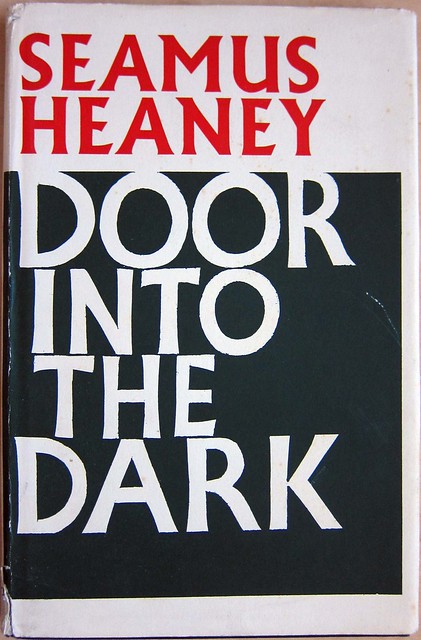
Seamus Heaney went on to publish many collections of poetry, as well as essays, translations, and dramatic works. But at his death, many of the remembrances quoted “Digging,” the very first poem in Heaney’s first published collection. In it Heaney describes his father’s and grandfather’s work on the family farm and concludes
But I’ve no spade to follow men like them.
Between my finger and my thumb
The squat pen rests.
I’ll dig with it.
The “squat pen” responsible for Death of a Naturalist would go on to compose some of the most iconic Irish poetry of the 20th century.
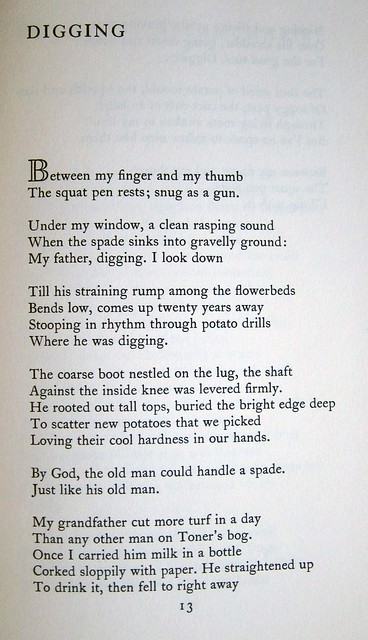
All of the images in this article are from Seamus Heaney titles originally owned by Liam Miller. ZSR Library’s Special Collections acquired Miller’s library and the Dolmen Press archives in 1986.

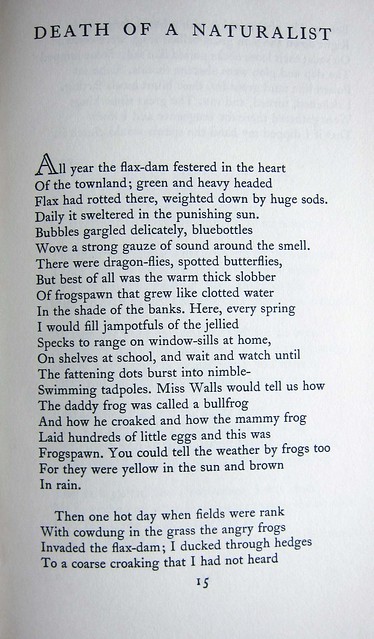
5 Comments on ‘Death of a Naturalist, by Seamus Heaney (1966)’
Well done, Megan, with a lovely tie to our collections.
Wonderful synopsis of Heaney and the Dolmen Press connection. I did not know, until I read your post, that Heaney’s first book of poetry was published by Liam Miller and the Dolmen Press, Thanks again for telling us about our collections!
Beautiful post, Megan.
Nice work “unearthing” this gem. I love the imagery of digging with a pen.
I love Seamus Heaney’s poetry and mourned his death. It’s wonderful to know of his connection to Dolmen and to see his handwriting in our collections!